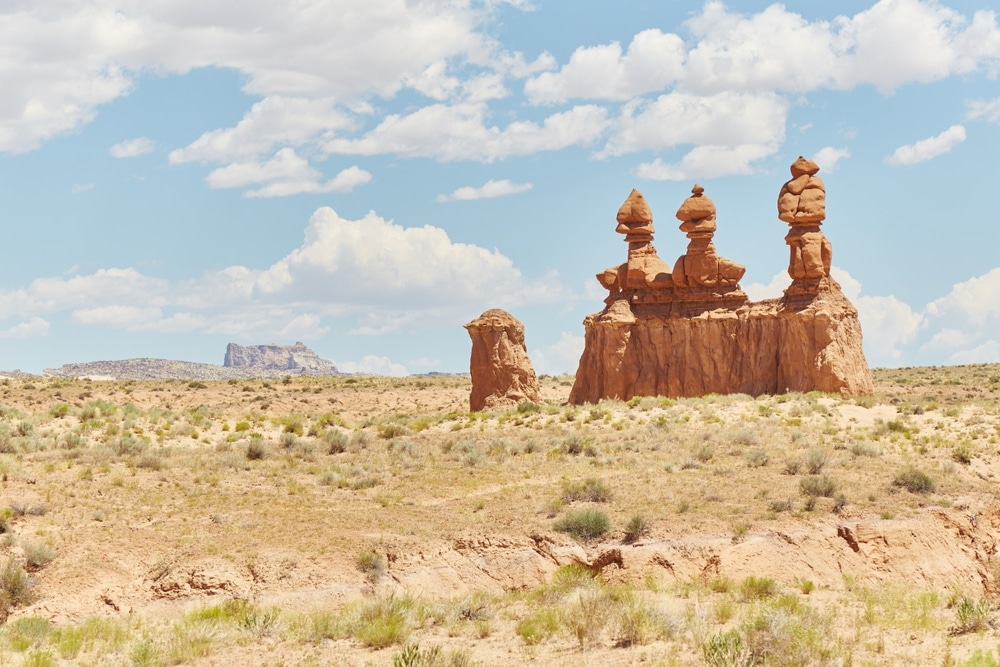- Privacy
- Terms
- Stay Connected
Nestled in the southeastern corner of Arizona, San Rafael State Natural Area stands as one of the state’s most pristine and ecologically significant protected lands. Established in 1999, this 3,557-acre natural area represents a rare ecological treasure where the Sonoran Desert meets unique riparian habitats along the upper Santa Cruz River. Located at approximately 31.3456° N, 110.6093° W, the park sits just north of the U.S.-Mexico border in Santa Cruz County, roughly 15 miles south of Patagonia and about 70 miles southeast of Tucson.
The heart of San Rafael is the historic San Rafael Ranch, with its sprawling grasslands, oak-studded hills, and the critically important Santa Cruz River headwaters. The ranch house itself, built in 1900, is a registered National Historic Landmark and serves as a stunning example of territorial ranch architecture. This Spanish Colonial Revival-style hacienda may look familiar to film enthusiasts—it was featured prominently in the classic 1958 western “Oklahoma!”

Unlike many of Arizona’s more developed state parks, San Rafael State Natural Area offers a glimpse into the state’s natural and cultural heritage in its most undisturbed form. As one of the least-visited units in Arizona’s park system, it provides a sanctuary not only for diverse wildlife but also for visitors seeking solitude and connection with the natural world away from crowds.
The park’s significance extends beyond its beauty—it protects some of the last remaining undisturbed shortgrass prairie in the state, serves as crucial wildlife corridor between the United States and Mexico, and safeguards a vital stretch of the Santa Cruz River, one of the few remaining perennial streams in southern Arizona. Conservation organizations recognize this area as one of the most biologically diverse regions in the entire Southwest, making it a place of exceptional ecological importance.

The combination of riparian corridors, expansive grasslands, and distant mountain views creates exceptional photography opportunities. Morning fog often settles in the river valley, creating ethereal scenes as sunlight filters through the mist and cottonwood canopy. Seasonal changes bring dramatic transformations, from summer monsoon storms to autumn colors in the riparian trees. Wildlife photography opportunities abound with patience and proper techniques.

The San Rafael Valley contains significant historical sites reflecting its ranching heritage and cultural connections to Mexico. The historic San Rafael Ranch House (viewable from designated areas but not open to the public) represents classic territorial architecture and served as a filming location for the 1950s western “Oklahoma.” Interpretive materials explain the area’s unique borderland history and the traditional ranching practices that helped preserve its natural characteristics.

The natural area protects diverse plant communities including rare Madrean oak woodlands, sacaton grasslands, and cottonwood-willow riparian forests. These habitats support unusual plant associations where species from different biological regions overlap at their range extremes. Wildflower displays following summer monsoon rains transform the landscapes with vibrant colors and attract numerous pollinators, creating fascinating opportunities for botanical photography and observation.

Several primitive trails traverse the diverse landscapes within this conservation area. The River Trail follows the cottonwood corridor along the Santa Cruz River, while the Grassland Loop showcases one of the finest remaining examples of native grassland in the Southwest. These unmarked routes require good navigation skills but reward adventurous hikers with solitude and pristine landscapes rarely experienced elsewhere in Arizona. The diverse elevations create varied habitat zones worth exploring in different seasons.

San Rafael State Natural Area represents one of Arizona’s premier birding destinations, protecting rare riparian habitat along the Santa Cruz River. The area supports over 300 documented bird species, including rarities like the gray hawk, elegant trogon, and varied bunting. The cottonwood-willow forests create crucial habitat for neotropical migrants, while surrounding grasslands host distinctive species including Botteri’s sparrow and grasshopper sparrow. The spring migration period (April-May) offers particularly exceptional birding opportunities when dozens of warbler species pass through.
Located far from urban areas with minimal light pollution, the natural area offers exceptional dark sky conditions for astronomy enthusiasts. The high elevation and clear air create ideal conditions for observing celestial objects. The open grasslands provide unobstructed horizons for viewing constellations, planets, and astronomical events against a dramatic landscape backdrop.

| Detail | Information |
|---|---|
| Location | Southern Arizona (Santa Cruz County, near the U.S.-Mexico border) |
| Established | 1999 |
| Size | Approximately 3,557 acres |
| Notable Feature | Historic San Rafael Ranch House (1900s) |
| Ecological Significance | One of the last intact short-grass prairie ecosystems in Arizona |
| Water Features | Santa Cruz River headwaters, cienegas (wetlands) |
| Elevation | 4,500-5,000 feet |
| Biodiversity | High biodiversity area with numerous threatened and endangered species |
| Wildlife | Over 200 bird species, rare fish, jaguar habitat, mammals, reptiles |
| Vegetation | Grasslands, mesquite bosques, riparian corridors, oak woodlands |
| Cultural History | Historic ranching operations, Native American archaeological sites |
| Film History | Setting for the classic Western film “Oklahoma!” (1955) |
| Access | Limited public access; permit required |
| Management | Arizona State Parks in cooperation with conservation partners |
| Conservation Status | Protected as a State Natural Area |
| Climate | High desert grassland: cool summers, mild winters |
| Nearby | Patagonia Lake State Park, Patagonia Mountains |
The landscape of San Rafael State Natural Area is defined by its remarkable diversity within a relatively small area. At elevations ranging from approximately 4,300 to 5,000 feet, the natural area encompasses high desert grasslands, riparian corridors, and oak-studded canyons that create a mosaic of habitats.
The Santa Cruz River, which originates just south of the park in Mexico, flows northward through the natural area, creating an essential ribbon of life. This stretch of the river represents one of the few remaining perennial segments of the Santa Cruz, meaning it flows year-round—a rarity in Arizona’s arid landscape. The river here is modest in size, typically 5-15 feet wide and 1-3 feet deep, depending on seasonal conditions, but its ecological impact is immense. The watershed captures approximately 5 square miles of drainage from the surrounding Patagonia and San Rafael Valley landscapes.
The river corridor is flanked by lush riparian vegetation that stands in stark contrast to the surrounding grasslands. Massive cottonwoods and willows create a shaded canopy over the gentle, meandering stream. These riparian areas represent less than 1% of Arizona’s total land area but support over 80% of wildlife species in the region.
Surrounding the river valley, the San Rafael Valley unfolds in a spectacular display of high desert grassland. These rolling grasslands, dotted with mesquite and oak, stretch toward the horizon and represent one of the most intact grassland ecosystems remaining in the Southwest. Geologically, the area features limestone and volcanic formations, with the Patagonia Mountains rising to the west and the Huachuca Mountains visible to the east.
One of the most remarkable geological features is the gentle basin structure of the San Rafael Valley itself—a broad, grass-filled valley surrounded by mountains that creates a unique “sky island” effect where diverse ecosystems exist in relative isolation. This geographical configuration has allowed for the evolution of specialized plant and animal communities.
The valley’s soils are predominantly deep, well-drained alluvial deposits that support the vigorous growth of native grasses. Ancient bedrock dating back to the Cretaceous period (approximately 145-66 million years ago) underlies the region, with periodic volcanic intrusions that have created the distinctive landforms visible throughout the natural area.
INSIDER TIP: The best views of the entire San Rafael Valley can be had from the eastern slopes of the natural area in early morning when the sun illuminates the grasslands and low fog often clings to the river corridor.
San Rafael State Natural Area hosts an extraordinary diversity of plant and animal life, representing a biological crossroads where species from the Sonoran and Chihuahuan deserts, the Rocky Mountains, and the Sierra Madre of Mexico converge. This convergence creates one of the richest biodiversity hotspots in North America.
The grasslands, which dominate much of the landscape, feature native species such as blue grama, sideoats grama, and lovegrass interspersed with scattered mesquite, acacia, and various cacti. These grasslands transition into oak woodlands at higher elevations, where Emory oak, Mexican blue oak, and Arizona white oak create shaded groves. Along the Santa Cruz River, the riparian corridor supports massive Fremont cottonwoods, Goodding’s willow, Arizona sycamore, and velvet ash. In spring and summer, wildflowers including Mexican gold poppy, lupine, and dozens of species of sunflowers create spectacular displays of color.
The natural area’s wildlife diversity is equally impressive. Over 200 bird species have been documented here, making it a premier destination for birdwatchers. Specialty birds include the elegant trogon, Montezuma quail, gray hawk, thick-billed kingbird, and varied buntings. The area is particularly renowned for rare species like the yellow-billed cuckoo and southwestern willow flycatcher, both federally listed threatened species that find sanctuary in the riparian habitats.
Mammals found within the natural area include mule deer, white-tailed deer, javelina, bobcat, gray fox, coati, and the occasional mountain lion. The grasslands support populations of antelope jackrabbit and prairie dogs. More elusive residents include the endangered ocelot and jaguar—species primarily associated with Mexico but occasionally documented in this borderland region.
The Santa Cruz River and its tributaries provide critical habitat for native fish species, including the endangered Gila topminnow and the Sonora sucker. Reptiles and amphibians abound, with notable species including the Sonoran mud turtle, Chiricahua leopard frog, and a variety of rattlesnakes, whiptails, and spiny lizards.
Seasonal ecological changes are pronounced at San Rafael. Spring (March-May) brings explosive wildflower blooms and the return of migratory birds. Summer (June-August) features dramatic monsoon storms that revitalize the landscape and trigger breeding activity for many species. Fall (September-November) sees golden grasslands and the southward bird migration, while winter (December-February) brings sparse but beautiful snow dustings and clear visibility across the valley.
IMPORTANT ALERT: The natural area provides critical habitat for several endangered species. Please stay on designated trails and observe wildlife from a distance to minimize impact on these vulnerable populations.
San Rafael State Natural Area offers a different experience from most Arizona state parks, focusing on low-impact recreation that preserves the natural character of this ecologically significant landscape. While facilities are limited, the opportunities for meaningful connection with nature are boundless.
Water activities are minimal due to the small size of the Santa Cruz River within the natural area. The river is generally too shallow for paddling, though there are occasional deeper pools suitable for cooling off on hot days. Swimming is not officially designated or managed within the natural area, and visitors should exercise caution around the riverbanks, which can be unstable.
Fishing is permitted in the Santa Cruz River with a valid Arizona fishing license. The river contains primarily Sonora sucker, desert sucker, longfin dace, and the endangered Gila topminnow (which must be immediately released if caught). The best fishing spots are found in the deeper pools beneath cottonwood groves, particularly in the northern section of the natural area. Standard Arizona Game and Fish Department regulations apply, with special provisions for the protection of endangered species.
Hiking represents the primary recreational activity at San Rafael, with several unmarked routes traversing the property. The San Rafael Grassland Trail (3.2 miles, moderate difficulty) loops through representative grassland habitat with spectacular mountain views. The Santa Cruz River Trail (2.4 miles, easy) follows portions of the river corridor, offering opportunities for wildlife viewing and birdwatching. The Oak Ridge Trail (1.8 miles, moderate to difficult) climbs to higher elevations through oak woodlands with panoramic vistas of the entire valley. Visitors should note that trails are minimally maintained and may be difficult to follow; bringing a topographic map is strongly recommended.
Photography enthusiasts will find endless opportunities at San Rafael, particularly during the golden hours of early morning and late afternoon when the grasslands are illuminated with warm light. Notable photography spots include the river crossing at the northern boundary (for riparian scenes), the eastern ridgelines (for panoramic landscapes), and the oak groves (for intimate woodland compositions).
Stargazing is exceptional due to the natural area’s remote location and minimal light pollution. The open grasslands provide unobstructed views of the night sky, with the Milky Way clearly visible on moonless nights. The best stargazing locations are in the central grasslands, away from the tree canopy of the riparian areas.
INSIDER TIP: Birdwatchers should visit in April and May when migrating species are passing through and resident birds are actively establishing territories and displaying. The riparian areas along the Santa Cruz River provide the greatest bird diversity.
San Rafael State Natural Area offers limited and primitive camping opportunities, emphasizing self-sufficiency and low-impact principles. The rustic nature of the facilities is in keeping with the natural area’s focus on preservation rather than development.
The main campground consists of just 10 designated primitive sites located in the eastern portion of the natural area. These sites are suitable for tents only—no RV or trailer facilities are available. Each site typically features a level tent pad, a simple fire ring (subject to seasonal fire restrictions), and a picnic table. There are no electrical hookups, water connections, or sewage disposal facilities. Campgrounds operate on a strict pack-in, pack-out basis, with no trash service provided.
Amenities at the campground are intentionally minimal. A single vault toilet serves the camping area, but no shower facilities are available. Potable water is not provided, so campers must bring all necessary water for drinking, cooking, and cleaning. Sites are well-spaced to provide privacy, with many offering views of either the grasslands or oak-studded hills.
Reservations for camping are required and must be made through the Arizona State Parks reservation system. Due to the limited number of sites and the growing popularity of this unique destination, reservations should be made 3-6 months in advance, particularly for spring and fall weekends. Camping fees are $15 per night per site, with a maximum stay of seven consecutive nights.
For those seeking more comfortable accommodations, options are limited but available in surrounding communities. The town of Patagonia, approximately 15 miles north, offers several bed and breakfast establishments, including the Duquesne House Inn and the Stage Stop Inn. Sierra Vista, about 30 miles east, provides a wider range of hotels and motels, including national chains. For a truly unique experience, the historic Hacienda Corona de Guevavi in Nogales (approximately 25 miles west) offers upscale lodging in a restored ranch setting similar to the San Rafael Ranch.
Camping regulations emphasize conservation ethics. Fires are permitted only in designated rings and are often prohibited during dry periods. Collection of firewood is not allowed—visitors must bring their own certified, pest-free firewood. Quiet hours are strictly enforced from 10 PM to 6 AM. The entire natural area operates under Leave No Trace principles, with special emphasis on minimizing water usage and proper disposal of human waste in the backcountry.
IMPORTANT ALERT: Due to the natural area’s proximity to the international border, visitors may encounter Border Patrol operations. Always carry identification and be prepared to answer questions about your activities in the area.
San Rafael State Natural Area operates under limited visitation schedules that reflect its primary mission of natural resource protection. The natural area is open Friday through Sunday from 8 AM to 5 PM year-round, with extended hours (8 AM to 7 PM) during summer months (May through September). It is closed to the public Monday through Thursday except for special pre-arranged educational groups or research permits.
Entrance fees are $7 per vehicle (up to four adults), payable at the entrance booth by cash or check only—credit cards are not accepted. An annual Arizona State Parks Pass ($75) covers entrance fees for all state parks and natural areas and represents a good value for frequent visitors. America the Beautiful federal passes are not accepted.
The best times to visit depend largely on your interests and tolerance for weather conditions:
Weather patterns at San Rafael are influenced by its 4,300-foot elevation. Summer monsoon season (July-September) brings afternoon thunderstorms that can cause flash flooding in the river and arroyos. Winter occasionally brings snow, which rarely lasts more than a day or two but can make roads impassable. Spring and fall typically offer the most stable and pleasant conditions.
Accessibility information is important to note—San Rafael has limited facilities for visitors with mobility challenges. The entrance area and short sections of trail near the ranch house are relatively flat and navigable for wheelchairs, but most trails traverse uneven terrain. The primitive restroom facilities are not fully ADA-compliant, though they do feature wider doors for wheelchair access.
Pets are permitted in the natural area but must be kept on leashes no longer than six feet at all times. Pets are not allowed in buildings or in the Santa Cruz River to protect water quality and sensitive riparian habitat. Owners must pick up and properly dispose of pet waste.
Cell service is extremely limited throughout the natural area, with most carriers showing no service or occasional single bars. Visitors should not rely on mobile phones for communication or navigation. Internet availability is non-existent, and no Wi-Fi services are provided.
INSIDER TIP: The roads to San Rafael can be rough and occasionally impassable after heavy rains. A high-clearance vehicle is strongly recommended, particularly if visiting during monsoon season. Always call ahead to check road conditions.
Facilities at San Rafael State Natural Area are intentionally minimal, reflecting the priority of habitat preservation over visitor convenience. These limited amenities require visitors to come prepared for a self-sufficient outdoor experience.
The visitor contact station is a small structure near the entrance that serves as the primary information point. It is staffed during operating hours by knowledgeable park rangers or volunteers who can provide orientation materials, trail information, and guidance about the natural area’s features. The station includes interpretive displays about the natural and cultural history of San Rafael, though these are modest compared to more developed state parks. A small selection of informational brochures is available, but no gift shop or retail operations exist on site.
Restroom facilities consist of two vault toilets located near the parking area and one at the primitive campground. These facilities are not flush toilets and have no running water. They are maintained regularly but represent the most basic sanitation provisions. No shower facilities exist anywhere within the natural area.
Potable water is not available anywhere in the natural area—all water for drinking and cleaning must be brought in by visitors.
Three designated picnic areas with a total of 12 tables are situated near the entrance. Each picnic site includes a table and trash receptacle, with several featuring simple stone fire rings (subject to seasonal fire restrictions). Two group ramadas can accommodate up to 25 people each and can be reserved for special events through the park reservation system. No electricity is available at any picnic or ramada site.
No boat ramps or marinas exist within the natural area due to the small size of the Santa Cruz River, which is not navigable by watercraft. Similarly, there are no designated swimming areas or beaches.
The natural area has no playgrounds or developed recreation areas beyond the hiking trails and open spaces. This absence of structured facilities reflects the emphasis on natural experiences rather than constructed entertainment.
No concessions or stores operate within San Rafael. The nearest supplies are available in Patagonia (15 miles north) or Nogales (25 miles west). Visitors must bring all necessary food, water, and equipment for their stay.
The historic San Rafael Ranch house is occasionally open for guided tours on select weekends, typically the first Saturday of each month. These tours must be reserved in advance through the Arizona State Parks reservation system and fill quickly. The ranch house represents the most developed facility within the natural area, though its primary purpose is historical interpretation rather than visitor services.
The remote location of San Rafael State Natural Area places it within reach of several other outstanding natural and cultural destinations, making it an excellent anchor point for exploring southeastern Arizona’s diverse attractions.
Patagonia Lake State Park, located approximately 20 miles north, offers a stark contrast to San Rafael’s undeveloped character. This popular park features a 265-acre man-made lake with developed facilities for boating, swimming, and fishing. Its campground provides full hookups for RVs, hot showers, and other amenities not found at San Rafael, making it a good alternative for those seeking more comfortable accommodations while still exploring the region.
The Patagonia-Sonoita Creek Preserve, managed by The Nature Conservancy and located about 15 miles north, protects another vital riparian corridor with excellent birdwatching opportunities. Over 300 bird species have been documented at this preserve, making it complementary to the birding experience at San Rafael.
Coronado National Memorial, approximately 30 miles east, commemorates the Francisco Vásquez de Coronado expedition of 1540-1542 and provides spectacular views of the San Pedro Valley from its high mountain setting. The visitor center offers excellent interpretive displays about the Spanish exploration period that shaped the region’s history.
The historic mining town of Bisbee, about 45 miles east, presents a wonderfully preserved example of early 20th-century Western architecture, with its Victorian buildings clinging to steep canyon walls. Tours of the Copper Queen Mine offer insights into the area’s mining history, while the town’s vibrant arts scene and dining options make it a worthwhile day trip.
The communities near San Rafael offer additional attractions. Patagonia features several art galleries, the locally famous Gathering Grounds café, and the Patagonia Museum focused on local history. Nogales provides an opportunity to experience border culture, with its vibrant downtown shopping district and ports of entry into Mexico. Sierra Vista offers more extensive shopping and dining options, as well as the renowned San Pedro Riparian National Conservation Area on its eastern edge.
Local businesses that complement a visit to San Rafael include Arizona Horseback Adventures in Sonoita, which offers guided rides through landscapes similar to those protected in the natural area. The Patagonia Creative Arts Center frequently hosts exhibitions by artists inspired by the San Rafael Valley landscapes. For visitors interested in the region’s wines, several tasting rooms in Sonoita and Elgin showcase wines produced from local vineyards that share the same watershed as San Rafael.
INSIDER TIP: Time your visit to coincide with the Santa Cruz County Fair, held annually in late September in Sonoita. This authentic rural fair showcases the ranching heritage that defined the San Rafael Valley for generations.
San Rafael State Natural Area represents one of Arizona’s most significant conservation achievements, protecting a rare combination of habitats that support exceptional biodiversity. The conservation story of this landscape, however, remains a work in progress requiring ongoing stewardship from both park managers and visitors.
The current conservation focus centers on maintaining the integrity of the Santa Cruz River headwaters. Park staff monitor water quality, flow rates, and riparian vegetation health through regular surveys and partnerships with academic researchers. Restoration efforts include the removal of invasive plant species such as buffelgrass and fountain grass that threaten the native grassland ecosystem. Controlled burns are occasionally implemented to maintain grassland health and prevent woody encroachment, mimicking natural fire regimes that historically shaped this landscape.
Visitor responsibilities form a crucial component of the area’s conservation strategy. All visitors are expected to adhere to Leave No Trace principles, with special emphasis on staying on designated trails to prevent soil erosion and vegetation damage. The “pack it in, pack it out” policy extends to all waste, including toilet paper when away from the vault facilities. Water conservation is particularly important—visitors should minimize soap use near natural water sources and conduct all washing activities at least 200 feet from the Santa Cruz River or its tributaries.
Volunteer opportunities exist for those wishing to contribute more directly to conservation efforts. The Friends of San Rafael, a nonprofit support organization, coordinates regular work days focused on trail maintenance, invasive species removal, and habitat restoration. Special scientific volunteer opportunities include the annual Christmas Bird Count and spring wildflower surveys.
Educational programs reflect the natural area’s emphasis on fostering environmental stewardship. Monthly naturalist-led hikes focus on various aspects of the area’s ecology, from grassland ecosystems to riparian habitats. The Junior Ranger program provides activities for younger visitors to learn about conservation while exploring the natural area. School groups can arrange special educational visits (even on weekdays when the park is normally closed) that incorporate Arizona science curriculum standards with hands-on field experiences.
The San Rafael Natural Area operates under comprehensive Leave No Trace principles:
IMPORTANT ALERT: The grasslands and riparian areas of San Rafael are particularly sensitive to human impact. Please stay on designated trails, avoid creating new paths, and never drive off-road vehicles through the grasslands.
The lands encompassed by San Rafael State Natural Area reflect thousands of years of human history, from ancient indigenous presence to Spanish colonial ranching traditions that continue to influence the cultural landscape today.
Archaeological evidence suggests human habitation in the San Rafael Valley dating back approximately 12,000 years, with artifacts from Paleo-Indian, Archaic, and later cultures discovered throughout the area. The O’odham (historically known as Pima and Papago) and Apache peoples utilized these lands extensively before European contact, with the perennial waters of the Santa Cruz River providing a critical resource in this semi-arid region.
Spanish influence began in the late 1600s when Jesuit missionaries, notably Father Eusebio Francisco Kino, established missions throughout the region. By the 1700s, Spanish land grants established vast ranches, including the San Rafael de la Zanja Grant of 1821, which encompassed much of what is now the natural area. This grant, one of the last issued by the Spanish Crown before Mexican independence, established European-style cattle ranching that would define the landscape for centuries to come.
The ranch’s modern history begins in 1882 when Colin Cameron, a Scottish immigrant, purchased the property and established the San Rafael Cattle Company. The elegant ranch house that stands today was built in 1900 by Cameron’s successor, Colonel William Greene, a controversial mining magnate who expanded the cattle operation significantly. The Spanish Colonial Revival architecture of the house, with its zaguan (central hallway) and interior courtyard, reflects the blending of cultures that characterized the Arizona-Sonora borderlands.
The ranch achieved cinematic fame when it was featured prominently in the 1958 film adaptation of Rodgers and Hammerstein’s musical “Oklahoma!” The ranch house served as the home of Laurey Williams (played by Shirley Jones), with many scenes filmed on the surrounding grasslands. This connection to Hollywood history adds another layer to the property’s cultural significance.
Indigenous connections to the land continue to the present day. The Tohono O’odham Nation considers portions of the San Rafael Valley to be part of their traditional territories, and tribal members maintain cultural practices connected to plants and landmarks within the natural area. The Arizona State Parks system works cooperatively with tribal representatives to protect culturally significant sites and incorporate indigenous perspectives into interpretive materials.
The natural area today serves as an important reminder of the region’s complex cultural heritage—from indigenous stewardship to Spanish colonization, from American ranching enterprises to modern conservation efforts. Interpretive programs highlight this multicultural history, emphasizing how different cultural practices have shaped the landscapes visitors see today.
The designation of San Rafael as a state natural area in 1999 represents the most recent chapter in this cultural history—a recognition that these lands hold values beyond agricultural production or resource extraction. As one of Arizona’s least-developed protected areas, San Rafael offers visitors a rare opportunity to experience landscapes that would be familiar to inhabitants from centuries past.
INSIDER TIP: Request information about the natural area’s “Voices of San Rafael” oral history collection at the visitor contact station. These recorded interviews with former ranch workers, local residents, and tribal members provide fascinating perspectives on the area’s human history.